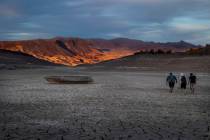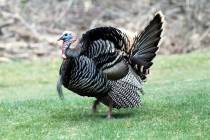Muzzleloader law revision in sight
Though I hate to admit it, my body has no problem telling my mind I'm getting older. I no longer can do some things as easily as I once did, whether it's my knees that ache at the mere thought of climbing a steep slope in search of a chukar covey, or my fingers that don't work as well in the cold.
I'm not the only one in this predicament. Statistics show American hunters are getting older, with their average age pegged anywhere from 39 to 44, depending on the study. The numbers might vary, but the higher end of the age spectrum is rising, meaning hunters are more susceptible to physical decline.
Eyes are a good example. For many of us, there seems to be connection between turning 40 and starting to wear glasses. Add another couple of years and your doctor will want to add "helper lenses" to your prescription.
As you might suspect, this sometimes hampers one's ability to properly focus on a set of iron sights and the intended target. For this reason, Toby Bridges of the North American Muzzleloader Hunting Association launched a movement targeting Nevada and 14 other states that don't allow the use of scopes or other modern sites, such as Red Dots, during a muzzleloader-only season.
Nevada law limits hunters during a muzzleloader-only season to the use of peep sights or traditional open sights. However, a provision allows those who choose to use a muzzleloader during any-legal-weapon season to use a scope during that season.
Despite the provision, Bridges thinks Nevada's law prohibiting the use of magnifying riflescopes during the muzzleloader-only season is discriminatory, and in 2006, he filed a complaint with the U.S. Department of the Interior (DOI), which controls the distribution of federal funds needed by states for wildlife management programs.
Bridges outlined his concerns this year in a letter to the Nevada Board of Wildlife Commissioners. He wrote, "Across the U.S. the average age of today's big game hunter is now well into the 40s. This is an age at which the majority of Americans begin to suffer from sight impairment.
"Most common is the loss of close focus. Almost as common is the growing inability of the aging eye to be able to change focus rapidly enough to be able to see a rear sight ... front sight ... and target (deer) at 50 ... 75 ... 100 yards somewhat in focus simultaneously.
"In other words, it becomes increasingly difficult for older hunters to be able to participate in the Nevada muzzleloader seasons/hunts due to unfair regulations that unethically prevents them from participating in this outdoor activity. And that is a violation of their rights."
The Interior Department agreed with at least part of Bridges' complaint and expressed concern that hunters with visual disabilities would not have equal access to muzzleloader hunting opportunities in Nevada, despite the current allowance for riflescope use on muzzleloaders during any-legal-weapon seasons.
According to a complaint timeline published on the Nevada Department of Wildlife Web site, the DOI ruled that state governments must provide reasonable modifications for persons who meet the definition of disability, which means to have a substantial limitation on a major life activity. A visually disabled person is a person with limited vision that cannot be corrected by glasses or contact lenses.
Bridges also contends that muzzleloader hunters with less-than-perfect vision need a riflescope to more precisely place shots on game and that, by denying the use of riflescopes, Nevada is actually encouraging wounding loss.
The Wildlife Commission will meet Friday and Saturday in Lovelock, and board members will be asked to determine how the state will best comply with the DOI ruling. The panel's options include everything from allowing nonmagnifying scopes only for hunters with a bona fide visual disability to permitting the use of riflescopes by all hunters.
Having grown up with Fess Parker's TV portrayal of Daniel Boone, I always liked the nostalgic feel of carrying a traditional muzzleloader into the field. I've long enjoyed the challenge associated with shooting primitive firearms with iron sights. But if the door to riflescopes is open to some, I believe it should be open to all.
Freelance writer Doug Nielsen is a conservation educator for the Nevada Department of Wildlife. His "In the Outdoors" column, published Thursday in the Las Vegas Review-Journal, is not affiliated with or endorsed by the NDOW. Any opinions he states in his column are his own. He can be reached at dougnielsen@att.net.

















